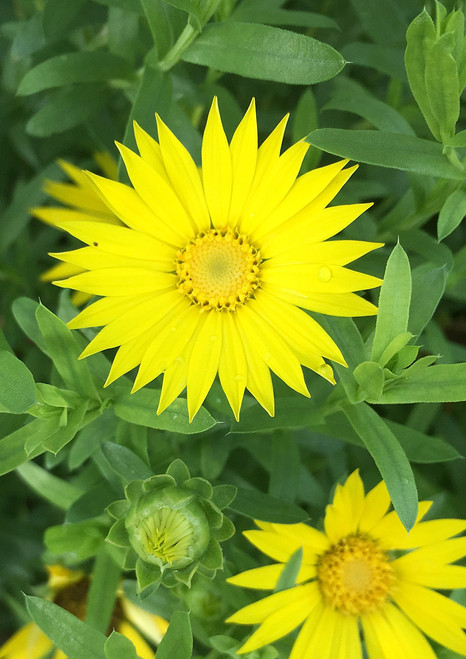Also known as Engelmann Daisy, this easy-to-grow perennial blooms from February to November, but mostly from March to July. At the base of the plant, the leaves are 6" to 12" long and deeply lobed, giving this wildflower the name Cutleaf Daisy. The foliage is very attractive on its own. Cut back the bloom stems when they have passed their prime, and the plant will be set to bloom again when conditions suit it. Cutleaf Daisies are a non-invasive perennial, but will re-seed themselves when conditions are right. They form a deep tap-root, which ensures that they will be there in dry or wet years. Plant them at the back of a flower border, and thin to about 1 foot between plants. Each plant will get larger the second and third years.
The Natives are Friendly
Fall is the time to start planning what wildflowers to plant for next year’s show. On everyone’s mind is the drought and watering restrictions. Now more than ever is the time to start converting manicured and groomed landscapes back to natives that can take what nature throws at them and come back for more. This year Cutleaf Daisy, Engelmannia pinnatifida, stood out along the roadsides of Texas. This delightful yellow daisy also known as Engelmann Daisy is named for a German physician and botanist named George Engelmann (1809-1884). He described over 108 species and upon his death his collection went to the Missouri Botanical Gardens. The yellow ray and disk flower heads can measure from 1-2” in diameter and in the intense heat, like this summer, the eight rays or petals of the flower heads curl under giving it a unique appearance. It is more prolific along side our roads because at least there it is protected from the ever constant pressure of grazing livestock, even though the deer and rabbits still snack on it. A diversity of birds & butterflies depend on Cutleaf Daisy for a nutritional food source. The yellow flowers give a ray of hope even in the driest times. The plant sprouts in the fall and forms a basal formation or winter rosette until spring when stems shoot up and the yellow daisies begin to emerge. The name cutleaf comes from its deeply lobed leaves, almost to the midrib. It can grow to 3 feet tall with slightly hairy stems. This plant is a dependable bloomer from February to November giving many months of yellow flowers to brighten the landscape whether in roadsides or planned native landscapes. Supplemental watering during dry spells can extend the bloom time. It thrives in full sun and calcareous soils throughout all of Texas. Cutleaf Daisy grows best in the wild from North Central Texas to the Edwards Plateau, and down to the open prairies of the South Texas plains. It has been seen as far North as South Dakota, East to Missouri, West to Arizona and South to Mexico. Cutleaf Daisy is definitely worth adding to any landscape for an easy yellow show of blooms this coming spring and summer.








































